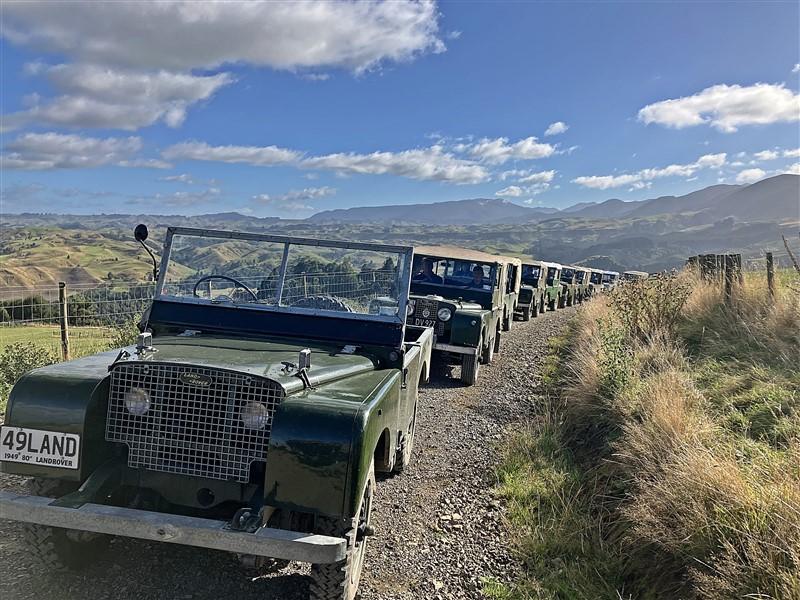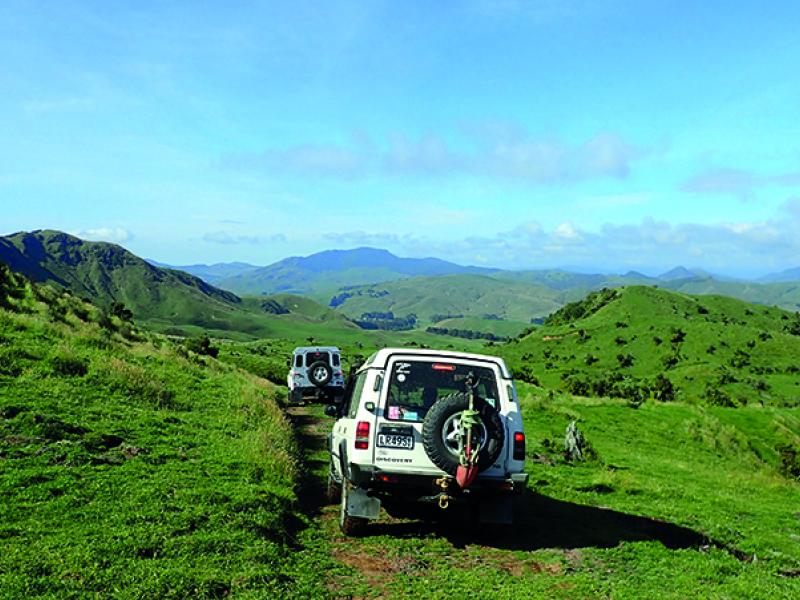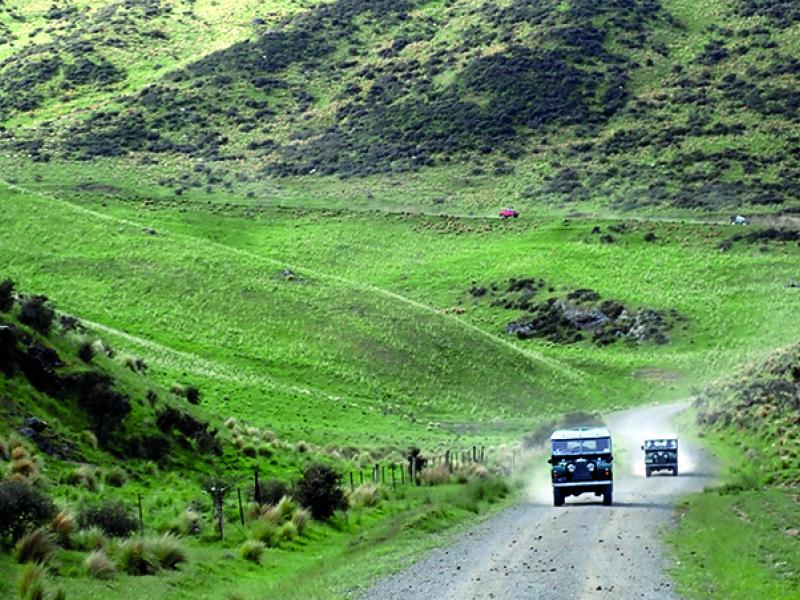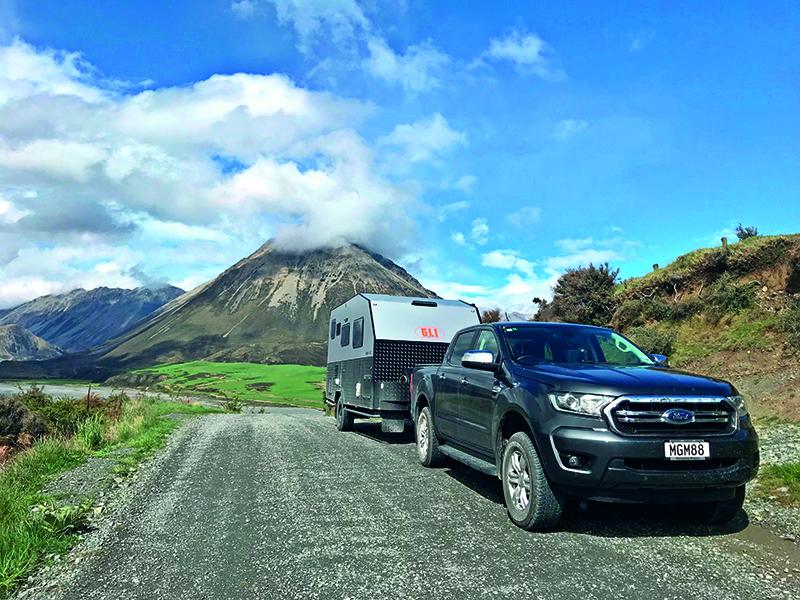Series 1 ‘Landies’ gather for off-road trek Words by Kevin Isemonger, images by Kevin Isemonger and Paul Furkert
There is nothing like a pending Land Rover Series 1 run to sharpen your focus on all those niggling little issues that you were supposed to have sorted out months ago.
For several months my 1955 Series 1 has been plagued with a slight case of asthma – but only at idle. Runs like a dream on the road – but coughs and spits at idle.
I dropped the carburettor off in October for a rebuild – and hadn’t heard back from the chap, so ended up chasing him for a bit. Swapped distributers around, changed the coil and the HT leads, and don’t even start me on the issues with condensers. I’m actually not sure what eventually sorted it out, but on the day it was idling “smooth like d’ silk” (Shaggy)
This year we met in Rangiwahia. Yeah, I had never heard of it before either, which is a good thing. Somehow, our trip leader Leon Zwetsloot had found the perfect spot for a bunch of Land-Rover fanatics to meet: ‘Basecamp Rangiwahia’ in the Manawatū. For the Wellington crowd it’s a casual three-hour drive north, but for the Auckland crew it’s a solid six or eight-hour slog south. My wife was not so keen to spend eight hours driving south in a vehicle with the acoustics of an empty biscuit tin, so kindly offered to take her own Land Rover south as a support vehicle. The sacrifices we make!
I hit the road just after 9am on Friday morning to get a head start and we arranged to meet at the two-hour mark in Otorohanga for a break. I stopped for fuel at Te Kuiti with lunch at my regular picnic area just north of Taumarunui. A ‘comfort-stop’ at Tangiwai as we pressed on south through Waiouru to fill the jerry cans in Taihape because were not passing any fuel stops for the next couple of days.
We crossed the (new!) bridge at Mangaweka and pushed on up the white clay cliff Ruahine Road avoiding the slips on the blind hairpin corners. None of your road-cone BS around here!
Google directed us to our home for the next couple of days at the Rangiwahia Basecamp. It was great to see the crew again, most of whom we had not seen since Taumarunui at the same time last year. Beers were soon popping as we all gathered in the large purpose-built kitchen area where we met our hosts, Hamish and Orelle McDonald and eight of their 10 children.
Saturday dawned clear and cool as we gathered outside the Camp kitchen again for our trip briefing of the day. The morning’s activity was to head over a low ridge to the Makiekie River then south down the Pohangina Valley Road to Takapari Road which we were to follow to our morning tea stop at the “traverse shelter” A-Frame hut high on the leading ridge of the Ruahine Ranges overlooking Dannevirke on the eastern side.
Reports had varied over the past few weeks of the state of Takapari Road, so Doug Pringle – our local guide – forged ahead to check if the track was passible. I was supposed to work my way up the convoy to follow Doug – but the usual chaos ensued with folks not stopping at intersections to wait for the vehicle behind – and we soon had chunks of our party heading in different directions. While we waited for the rest of the crew to catch up at the Takapari Road intersection I noticed an old overgrown house. This turned out to be the old Delaware Flats Post Office, which was originally the Piripiri Post Office, but was moved across the river to Delaware Flats in the early 1900s.
The metalled road winds its way through cleared farmland gaining altitude quite quickly before ending abruptly at a gate and the start of the clay track with a reasonable turning area before entering the bush. By the time I reached the edge of the bush – Doug had already shot up the track in his 1957 with Paul Furkert in his 1949 Series 1 to check out the conditions ahead. The report came back via the PRS that the track was impassible, and that Paul had slid off the edge of the track, so I was dispatched to assist with the recovery.
The end of the farm section of Takapari Road reduces to a clay 4WD track, easy going for the first short section with overhanging bush and then the track attacked a shattered rock section that had eroded leaving solid steps – which would not usually be an issue in the coil sprung Discovery – but shook the fillings out of my head and blurred my vision on leaf springs with tyres still at 36psi. Ahead was a slope of yellow clay with deep erosion channels – and perched, wedged and bellied out on the tight right-hand corner was Pauls 80” Series 1.
Doug had made it up to the next ‘zig’ turned and attached a winch cable which soon dragged Paul off the hump. I walked up the greasy clay track to the next corner and a by-pass track had been cut up through the bush, but that had scoured out badly with a large soft section at the base. The main track had a large hole with a near-vertical climb out. I would suggest that just to get a few vehicles through this section alone would take most of the morning and would test a well-equipped club truck – so it was a no-go from me. Many of the vehicles on these trips are valuable museum pieces and owners have invested heavily in their restoration. It was also evident on the LR75 trips in Wanaka that many have never driven off-road before. To be fair, we were not even close to getting to the A-Frame hut for morning tea. From our turn-around point it was six kilometres as the crow flies to the ridge, with an additional three kilometres along the ridge-top to the hut.
Although we failed to reach our goal, there is no doubt that a few of us will return when the mud cracks to give it another go.
So we turned our muddy Landys around and bumped our way back down to the track to meet up with the rest of the crew – finishing off their morning tea.
Our next destination – and proposed lunch-stop is Luttrells Garden & Museum in Pohangina. Not too difficult – just follow the valley road south – and turn right after crossing the river. Yeah – right. We called in for a photo shoot at Totara Reserve – but again, someone didn’t wait at the intersection and more than half the crew overshot the turn-off – so we lost 15 vehicles for a while. Churchill Road to Totara Reserve is interesting as it follows an erosion ridge of the Pohangina River which used to link up with our afternoon destination of Ngaputahi Station – but cyclone Gabriel took the bridge out.
Our lunch stop at Luttrells Gardens and Museum on Pohangina Road is a private collection of historical industrial and horticultural items along with the Manawatū’s largest remaining stand of Kahikatea – New Zealand’s tallest-growing native tree.
From Luttrells – we went all the way up the back and gone on dusty trails with great views out over the Pohangina valley we just travelled down. This part of New Zealand is like a giant unmade bed with waves of valleys travelling north to south. These are successive fault lines that have been forced up and crushed together on the edge of the Pacific and the Australian Plate. I have visited many telecommunications high sites in this region over the years and it is easy to become confused which valley you are in.
We popped out the southern end of Zig-Zag Road and headed back north – past Luttrels gardens (again) and on to Ngaputahi Station. My wife and I have a small farmlet in Auckland where we run 60 Ewes with the usual issues of scouring and flystrike so I was fascinated to learn at Ngaputahi Station that they rarely drench and have statistically proven that fly-strike is a genetic disorder, not just bad luck for the sheep. Angus, the farm owner and manager maintains the absence of chemical produced a better tasting beef and lamb meat product.
We were guided up the adjacent hillside before descending, crossing Makiekie (Coal) Creek and climbing 250m to the farm’s airstrip with a 200m drop-off on the eastern side to the Pohangina River below.
We inched our way down the steep farm track to Pohangina Road which then climbed to follow the ridge between the Pohangina and Makiekie Creek with many dusty lefts and rights and then descended to Utuwai where we followed Makoura Road to our evening meal at the Apiti Tavern. After getting lost a few times – 10 hours on the road and 140 km later – we arrived an hour early for dinner but just in time for a well-deserved beer and an excellent meal to end our dusty day.
Sunday we were up and off early as we had quite a list of places to see and things to do, most of which we failed to achieve though I suspect no one really noticed. We headed into the thriving metropolis of Rangiwahia with its immaculately kept community hall and fire station (that’s all folks) before turning onto ‘Peep-O-Day Road.
Back in 1996 myself and some mates participated in the Manawatū ‘Coast-to-Coast’ 4WD Safari and we drove for hours (or so it felt) along Peep-O-Day Road and here we are again, same road, same vehicle (yep!) and same stunning views all the way north to Mount Ruapehu.
Peep-O-Day does eventually end, and as we continued to Upper Pakihikura Road, Mangapapa Road, Wapuru Road, Mangamako Road, Otara Road and finally Peka Road where we entered a farm to visit the ‘White Cliff Boulders’ on the side of the Rangitikei River. Due to more condenser issues and a pesky leaking tyre, the day had got away on us, so our morning stop became our lunch stop which was supposed to be at a Mangaweka Café after visiting a ‘retreat’ and the old Mangaweka Power House.
The ‘White Cliff Boulders’ are calcite concretions like the Moeraki boulders down south. They are formed when sedimentary mud comes in contact with a cementing mineral – like taking a syringe of glue and injecting it into a sand pit. The resulting clump of glue-bound grains hold together while the surrounding softer material is eroded away, exposing these freaks of nature. The location of this concentration of the large mud-rock boulders is quite surreal among a thick grove of titoki and rimu on the banks of the Rangitikei.
Following brunch the farmer kindly allowed us to press on through their farm to scale some razer-back ridges and pop out on Mangarere Road where we made our way across the river to SH1 just west of Mangaweka. Some of the group topped up their tanks while others made their way across to a café on the far side of the Rangitikei for an ice cream. Others who could follow instructions were on the other side of the river at the camp, but not at the correct muster station.
Camp Leader eventually found us and rounded everyone up at the (upper) Mangaweka Camp – but of course we were all parked at different angles, so jammed in like timber wedges and hard to back out with poor visibility.
Eventually we headed back out via Ruahine Road following the Mangawharariki River.
Once the altitude was gained the valley opens up where we stopped at the Mairenui Rural Retreat to pay our respects to a couple of hard-working Series 1s before scampering back to the Basecamp for an urgent Medicinal Beer to remove the “calcite concretions” from the backs of our throats.
Our hosts, the McDonald family, provided a great vegetarian dinner for us all in the camp kitchen as stories of barn-finds and rescued-from-the-scrap-heap Series 1’s carried on till late into the night.
It was our last day. It was a sombre crew who peeled their way across the compound to head home. Since we missed out on visiting the remains of the Mangweka Power Station and the abandoned rail tunnel high above Mangaweka we thought we would check it out on our way through. By this stage a contingent had already left, so we thought we might catch them up – but alas, the power house was deserted, so we had a quick look and pushed on to the rail tunnel up Te Kapua Road.
Upon returning to the Land Rover a convoy of Series 1s arrived. No idea of how we had passed them, but we all said our ‘Goodbyes’ (again) and commenced our long drive north.
Thank you to all the attendees – Leon and Doug for their reconnaissance work – the McDonald family for the use of their camp and support through the night and will see you all again next year – wherever that may be.







